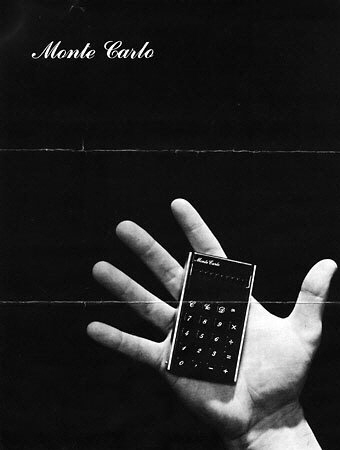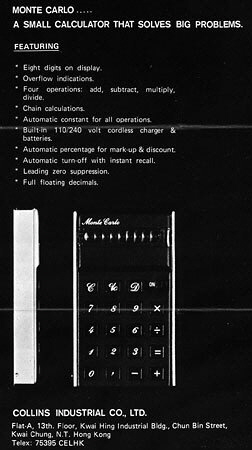Monte Carlo
& similar models
Similar tiny calculators with a rechargeable battery pack which plugs directly into the AC supply. There are differences in detail between the battery packs but these all appear to have been manufactured by the same, unknown, company.
Advanced models with square root and memory:
- Cybio 004m - a slightly larger model.
- CB-888 - unusually has a green VFD display.
Model with scientific functions:
Note that now that they are very old the batteries are likely to have degraded and not hold charge. It is now not recommended to connect the battery module to an AC outlet.
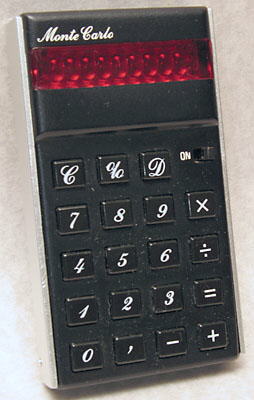
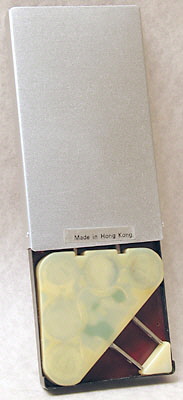
Monte Carlo
With the rear casing slid up to reveal the "Energizer" battery pack.
Monte Carlo
Distinctive features: A tiny calculator. Battery pack unplugs from the calculator and plugs directly into the AC supply.
Technical details:
Display is 8 digits, red LED.
4-function, %.
Integrated circuit - probably Texas Instruments TMS0803NL, see UIT 85X below.
Size 52 x 90 x 14 mm. (2.0" x 3.5" x 0.55").
About 1975.
Manufactured in Hong Kong, possibly by (or distributed by) Collins Industrial Co., Ltd.
This is a noticeably tiny calculator, but the novel feature is that the battery pack unplugs from the calculator and plugs directly into the 110V AC supply.
The body of the battery pack measures 36 x 48 x 8 mm () and contains
rechargeable button cells.
Note that now that they are very old the batteries are likely to have degraded and not hold charge. It is now not recommended to connect the battery module to an AC outlet.
Further down this page are similar models.
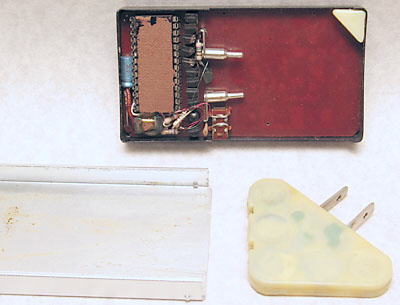
The cover and the battery pack have been completely removed. The brown coating on the integrated circuit is adhesive from the insulating tape which covered the electronic components.
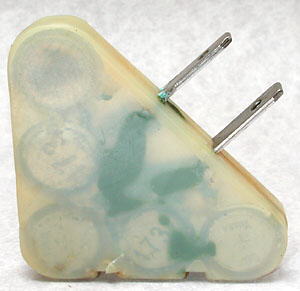
The rechargeable button cells can be seen through the translucent casing of the battery pack.
Advertising brochure from 1975 for the Monte Carlo (click on each image to see a larger version).
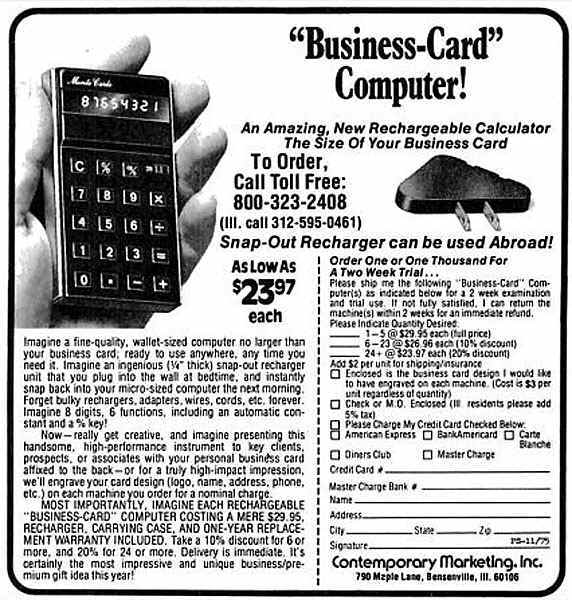
Advertisement from November 1975 for the Monte Carlo "Business-Card" Computer!
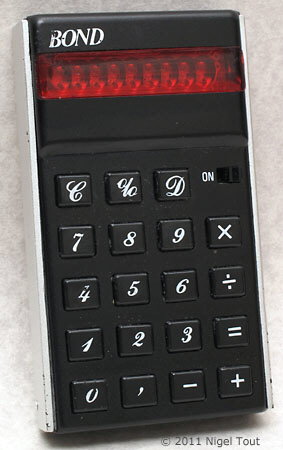
This Bond calculator comes in a box marked "Monte Carlo".
The instructions on the box for the "110/240 Volt Energizer" are "Remove Energizer and plug into any wall socket overnight for power restoration".
Note that now that they are very old the batteries are likely to have degraded and not hold charge. It is now not recommended to connect the battery module to an AC outlet.
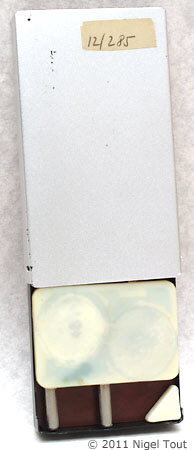
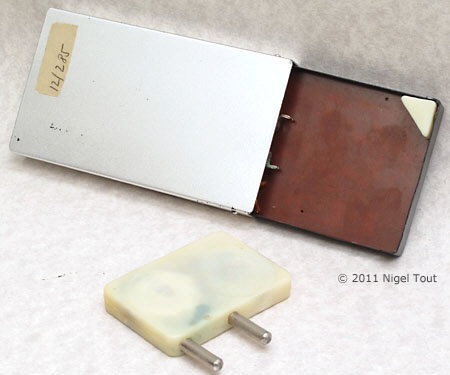
The calculator and the "energizer".
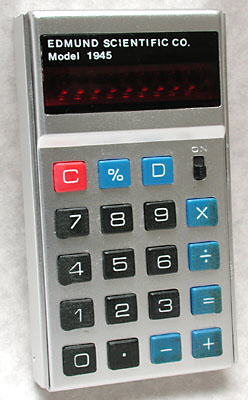
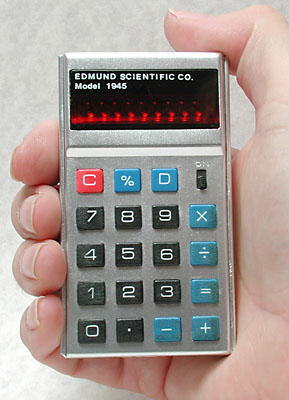
Edmund Scientific 1945
Edmund Scientific is a U.S. mail-order supplier of scientific instruments and components.
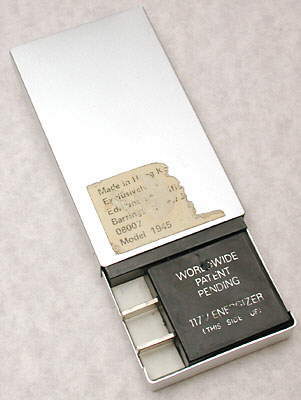
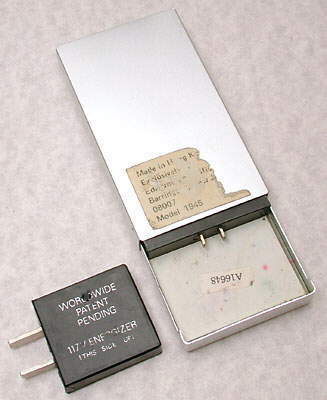
After sliding up the back cover the rechageable battery pack is revealed. This can be unplugged from the calculator and plugged straight into the AC supply for recharging.
Note that now that they are very old the batteries are likely to have degraded and not hold charge. It is now not recommended to connect the battery module to an AC outlet.
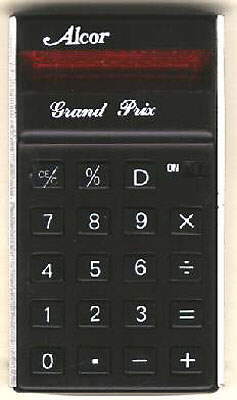
Alcor Grand Prix.
This model has a triangular battery pack.
Inside, the calculator is marked "Made in Hong Kong".
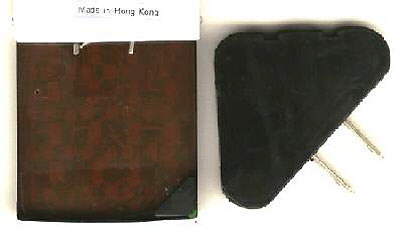
Here the battery pack has been unplugged and removed from the rear of the calculator.
Note that now that they are very old the batteries are likely to have degraded and not hold charge. It is now not recommended to connect the battery module to an AC outlet.
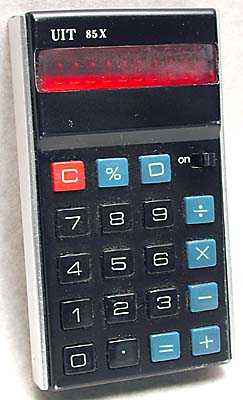
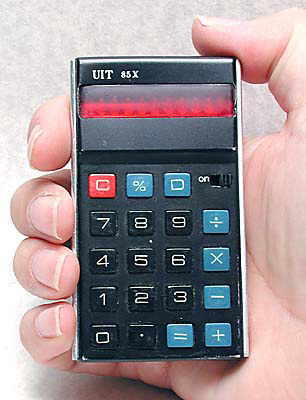
UIT 85X
Integrated circuit - Texas Instruments TMS0803NL (here date coded week 23, 1975).
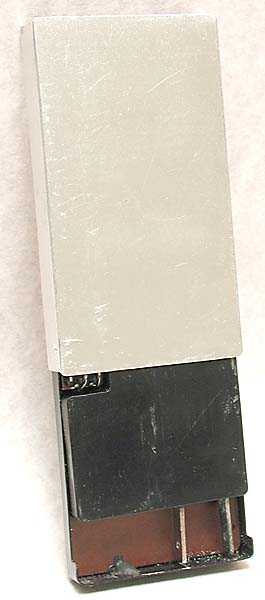
The rear of the calculator with the back cover slid up so that the battery pack can be unplugged for recharging.
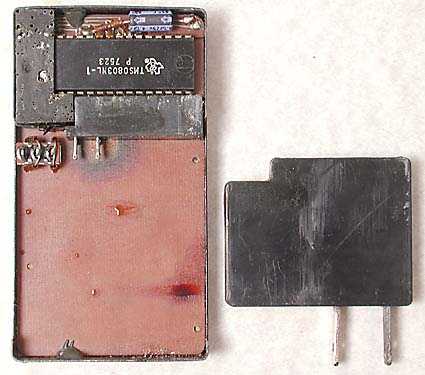
The rear cover of the calculator has been completely removed to reveal the minimal electronics in this machine.
The battery pack has been unplugged from the calculator, and shows the two prongs for plugging directly into a U.S. type 110V AC power outlet.
Note that now that they are very old the batteries are likely to have degraded and not hold charge. It is now not recommended to connect the battery module to an AC outlet.
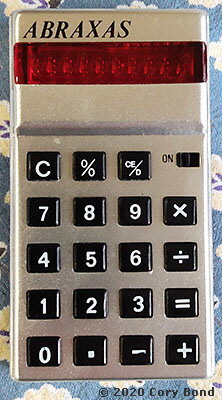

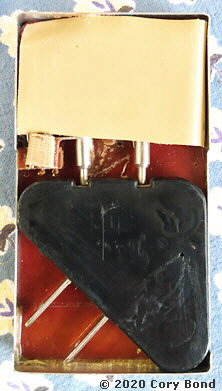
The rear cover has been removed to reveal the battery module connected by sprung contacts to the electronic board (which is covered by insulating tape).
ABRAXAS
4-function, %, with red LED display.
This model originates from Canada, from an unknown marketing company.
The photographs of this model were kindly provided by Cory Bond.
Here the battery module has been removed from the calculator allowing it to be recharged from an AC supply.
Note that now that they are very old the batteries are likely to have degraded and not hold charge. It is now not recommended for the battery module to be connected to an AC outlet.
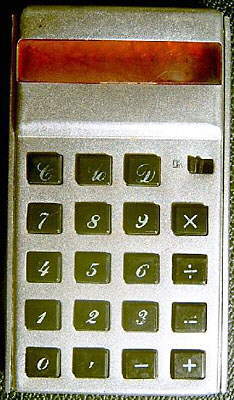
Unknown model.
These photographs of a similar calculator without a name were kindly provided by Juan Luis de la Peña
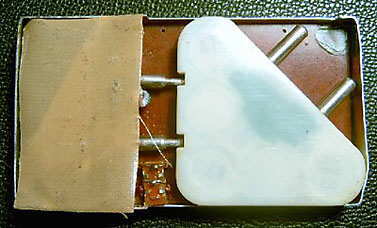
Here the rear has been removed to reveal the battery pack, which is a different shape to that of the UIT 85X, above.
Being made of opal plastic allows us to see the five rechargeable button cells inside.
Note that now that they are very old the batteries are likely to have degraded and not hold charge. It is now not recommended to connect the battery module to an AC outlet.
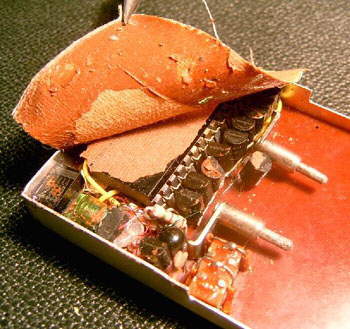
Showing the very compact electronics into which the battery pack plugs.
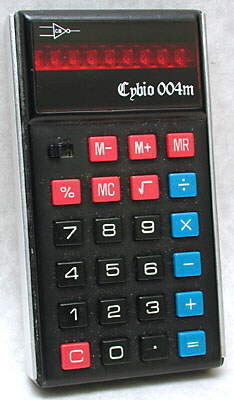
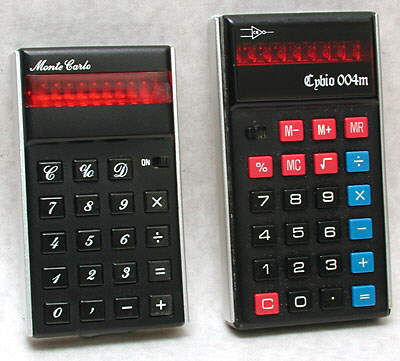
Cybio 004m
Distinctive features: A tiny calculator. Battery pack unplugs from the calculator and plugs directly into the AC supply.
Technical details:
Display is 8 digits, red LED.
4-function, %, memory, square root.
Integrated circuit - Rockwell A5902CA (here date coded week 12, 1976).
Size 56 x 103 x 15 mm. (2.2" x 4.1" x 0.6"). This calculator is a little bigger than the other models illustrated here, as can be seen in the photograph above right where it is compared with the Monte Carlo.
About 1976.
The power pack here is designed to be plugged into a 220v AC outlet for recharging.
Note that now that they are very old the batteries are likely to have degraded and not hold charge. It is now
not recommended to connect the battery module to an AC outlet.
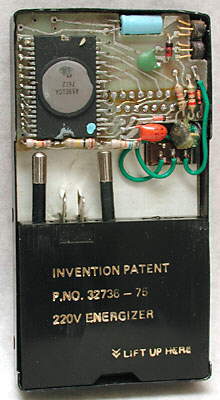
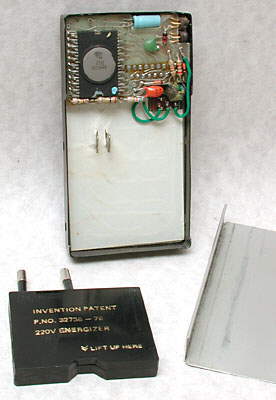
The back has beed removed to reveal the circuit board with the Rockwell integrated circuit and the power pack.
The power pack has been unplugged from the calculator and can now be plugged into a 220v AC power outlet for recharging.
Note that now that they are very old the batteries are likely to have
degraded and not hold charge. It is now not recommended to connect the battery module to an AC outlet.
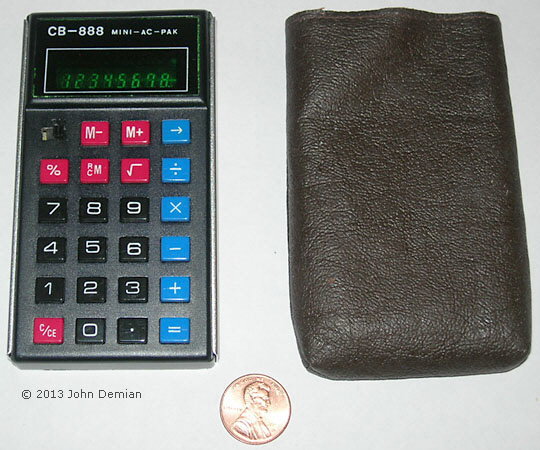
CB-888
Distinctive features: A tiny calculator. Battery pack unplugs from the calculator and plugs directly into the AC supply.
Technical details:
Display is 8 digits, green VFD (Vacuum Fluorescent Display).
4-function, %, memory, square root.
This model unusually has a Vacuum Fluorescent Display rather than the red LED display of the other models on this page.
Note that now that they are very old the batteries are likely to have degraded and not hold charge. It is now not recommended to connect the battery module to an AC outlet.
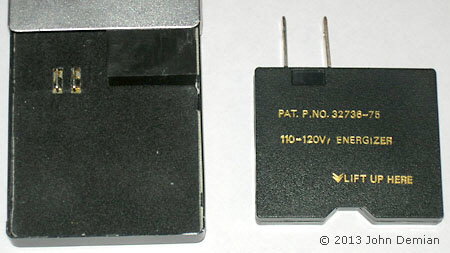
The rear of the casing slides up to allow the power pack to be removed and inserted into an AC supply for recharging.
The photographs of this model were kindly provided by John Demian.
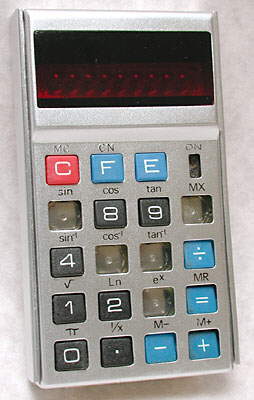
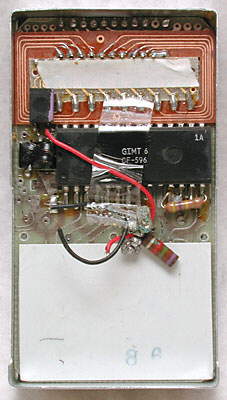
Distinctive features: A tiny calculator. Battery pack unplugs from the calculator and plugs directly into the AC supply.
Technical details:
This scientific model, although without any name or model markings, is also believed to be from Edmund Scientific
This calculator has been taken apart (it has been suggested that maybe the battery, which is missing, no longer held charge) and some components, including key caps, have been lost.
The operating instructions which came with it illustrate the display as 8 digits which changes to scientific mode for very large or small numbers with 5 digits mantissa and 2 digits exponent.
Hand-held Calculators
Vintage Calculators
Text & photographs copyright, except where stated otherwise, © Nigel Tout 2000-2025.
